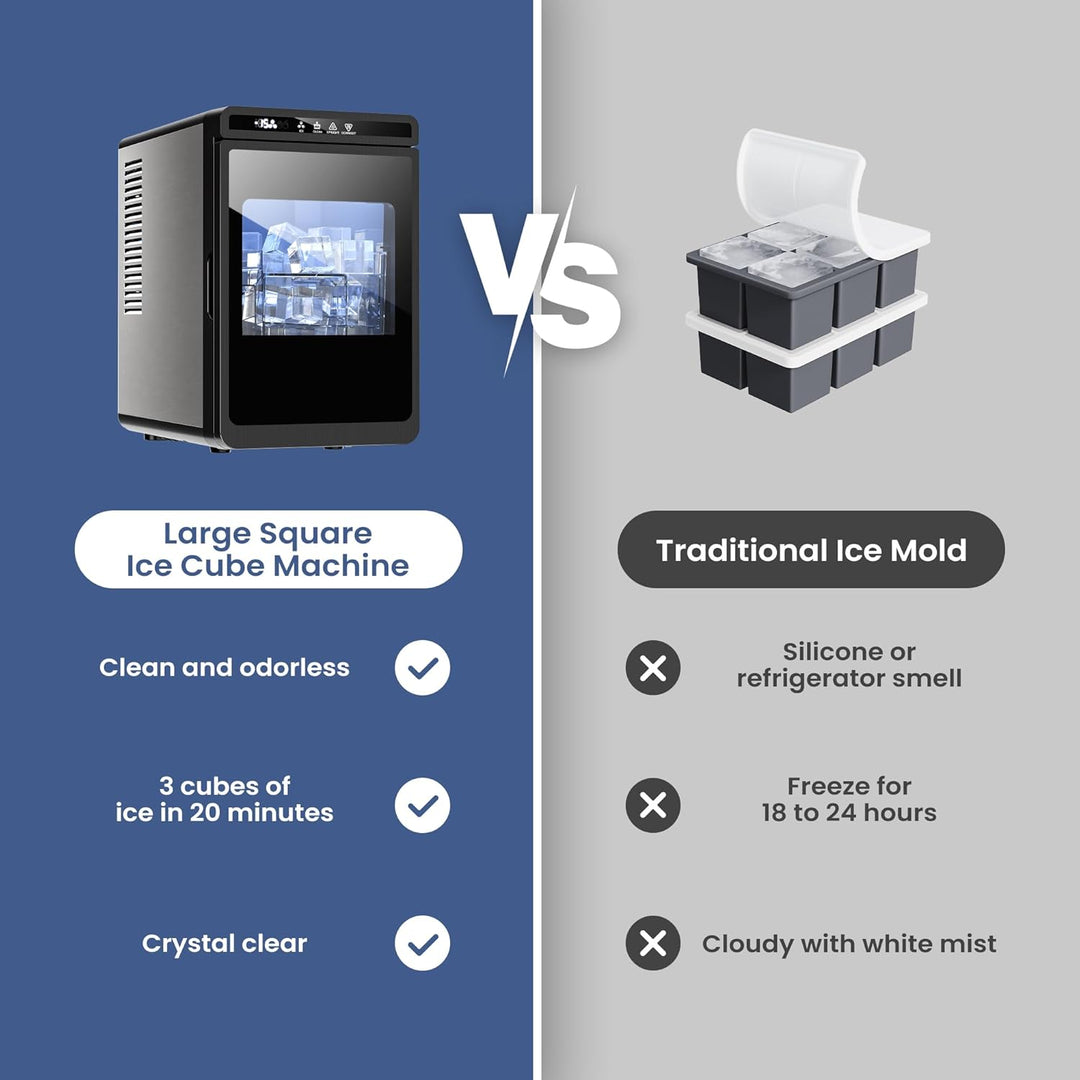How to Clean Kismile Ice Maker – Easy Steps
This post contains affiliate links. As an Amazon Associate, we earn from qualifying purchases.
That first sip of sweet tea on a hot day hits differently with perfectly clear, crisp nugget ice from your Kismile machine—until yesterday’s ice suddenly tastes stale or develops odd odors. When your Z5815SNH model (or similar Kismile nugget ice maker) slows down or produces cloudy cubes, mineral buildup and bacterial growth are likely sabotaging your ice quality. Learning how to clean Kismile ice maker properly transforms it from a potential health hazard back into your most reliable kitchen companion. This guide delivers exact weekly maintenance routines and deep-cleaning protocols that restore peak performance, prevent costly repairs, and ensure every cube meets your standards.
Neglecting ice maker maintenance isn’t just about bad-tasting ice—it creates breeding grounds for mold and bacteria like salmonella and E. coli. Regular cleaning extends your machine’s lifespan to a decade while improving ice clarity and chewy texture. Whether you own the popular Z5815SNH model or another Kismile nugget ice maker, follow these specific procedures to keep your appliance running efficiently. You’ll master both the quick self-cleaning cycles and thorough manual processes that commercial kitchens rely on, all adapted for home use.
Activate Kismile Self-Cleaning Mode Correctly
Your Kismile ice maker’s built-in cleaning system handles weekly upkeep with minimal effort, but incorrect activation causes incomplete cleaning. This automated process circulates solution through hidden reservoirs and transport pipes where mineral deposits accumulate fastest—areas manual cleaning often misses.
Press and Hold Until Water Circulates
Locate the “ice clean” button on your control panel (clearly labeled on Z5815SNH models). Fill the reservoir with room-temperature water only—never hot water, which warps internal plastics. Press and hold the button until you hear water actively pumping through the system. Release the button once circulation begins; the machine will run a 10-15 minute cycle automatically. For heavy mineral buildup in hard water areas, repeat this process 2-3 times weekly until performance improves.
Schedule Cleaning Around Your Usage Patterns
Run self-cleaning weekly for standard home use (1-2 batches daily). Heavy users making ice 4+ times daily should activate it 2-3 times weekly. In hard water regions, clean weekly regardless of usage—mineral deposits accelerate even during low use. Pro Tip: Set phone reminders for Sunday evenings when you’re likely prepping for the week ahead. Consistent scheduling prevents scale from hardening into stubborn deposits that require aggressive manual cleaning.
Manual Deep Cleaning: Fix Stubborn Buildup in 4 Phases

When self-cleaning fails to resolve cloudy ice or slow production, manual intervention targets hidden grime. This comprehensive process takes 30-45 minutes but restores factory-level performance. Always unplug the unit first—residual power risks electrical damage during cleaning.
Power Down and Empty Components Completely
Unplug the unit and confirm no power remains. Remove the ice basket and discard all contents, including stuck ice chips (use white vinegar on a cloth to loosen stubborn pieces). Open the drain plug—positioned for direct sink drainage—and rinse the reservoir with warm water to flush loose debris. Never skip this step; residual ice dilutes cleaning solutions and reduces effectiveness.
Select and Apply the Right Cleaning Solution
Choose from these proven options:
– Commercial ice maker cleaner (follow package ratios)
– Equal parts white vinegar and water
– Baking soda paste mixed with warm water
Always use filtered water to prevent adding new minerals. Fill the reservoir to the “full” line with your solution, then run 2-3 complete ice-making cycles. Discard every ice batch—these contaminated cubes contain cleaning chemicals unsafe for consumption. Stop when half the solution remains to maximize contact time with problem areas.
Scrub Critical Zones Commercial Cleaners Miss
Remove the storage basket and soak it in warm soapy water for 10 minutes. For internal components, use a soft cloth dipped in cleaning solution to wipe the reservoir, lid, and visible surfaces. Target hidden trouble spots with precision tools:
– Toothbrush: Scrub behind prongs and around ice chute openings
– Q-tips: Clean sensor areas where residue triggers false errors
– Spray bottle: Mist solution into tight crevices without flooding electronics
Warning: Never use abrasive pads—they scratch surfaces where bacteria hide.
Rinse Thoroughly to Eliminate Chemical Aftertaste
Incomplete rinsing leaves vinegar or cleaner residue that taints ice taste for days. This two-stage protocol ensures total removal while protecting sensitive components.
Flush Reservoir with Cold Water
Use your sink sprayer on low pressure to rinse the reservoir, focusing on corners where solution pools. Cold water works best for vinegar solutions—it neutralizes lingering odors faster than warm water. Follow with a spray bottle filled with fresh water to target narrow channels the main rinse misses. Drain completely through the plug before proceeding.
Run Validation Cycles Before Using Ice
Refill with filtered water and run 3-4 full ice-making cycles, discarding every batch. This flushes residual solution from transport pipes where contaminants hide. After the final cycle, dry the interior with a lint-free towel, then run one more cycle and discard the ice to catch stray fibers. Your machine is ready when ice tastes completely neutral.
Prevent Scale Buildup With Daily Habits
Hard water minerals cause 80% of Kismile performance issues. These simple daily actions reduce deep-cleaning frequency by up to 60%.
Filter Water Before Every Fill
Install an affordable faucet filter or use pre-filtered water exclusively. This blocks calcium, magnesium, and iron that create chalky deposits inside pumps and reservoirs. Filtered water produces visibly clearer ice with that signature Kismile chewy texture while extending time between deep cleanings from 4 to 8 weeks.
Wipe Countertops After Ice Dispensing
Spills and countertop dust migrate into the machine during ice dispensing. Keep a microfiber cloth nearby to wipe the base and surrounding area immediately after each use. This prevents sugar residues from sweetened drinks from feeding mold growth inside the unit.
Spot Cleaning Problems Before They Worsen

Your ice maker sends clear signals when maintenance is overdue. Recognize these issues early to avoid emergency cleaning sessions.
Identify Critical Warning Signs
Act immediately if you notice:
– Ice develops sour or musty odors (indicates mold growth)
– Cubes stick together or to machine components (mineral buildup)
– Visible white chalky deposits on internal surfaces
– Machine runs longer than usual to produce a batch
Note: Some Kismile models naturally produce slightly cloudy ice—focus on sudden texture or taste changes instead.
Avoid These 3 Costly Cleaning Mistakes

Common shortcuts damage your machine or create health risks. Steer clear of these errors:
Never Use Boiling Water or Corrosives
Boiling water melts internal plastics, warping seals and pumps. Corrosive cleaners (like bleach or oven degreasers) etch metal components and leach toxins into ice. Harsh chemicals also void your warranty—Kismile explicitly prohibits them in manuals.
Safe Alternatives That Actually Work
Stick to these effective, machine-safe options:
– White wine vinegar (gentler than distilled for odor control)
– Baking soda paste for stubborn organic residue
– Lemon juice for light descaling (less acidic than vinegar)
– Mild dish soap only on exterior surfaces (never inside reservoir)
Custom Cleaning Schedule Based on Your Usage
One-size-fits-all timelines fail most users. Match your routine to actual machine demands:
Adjust Frequency for Your Household
- Light users (1 batch weekly): Deep clean every 8-10 weeks
- Daily users (1-2 batches): Clean every 4-6 weeks
- Entertaining households (frequent batches): Clean every 2-3 weeks
Pro Tip: Mark your calendar for cleaning 2 weeks before peak summer—don’t wait for a party emergency.
Verify Cleaning Success With Ice Quality Tests
After cleaning, confirm your machine is truly ready for use with these checks:
Confirm Crystal-Clear Ice Production
Run a test batch and inspect:
– Texture: Should be uniformly soft and chewy (no hard chunks)
– Clarity: Transparent with no cloudiness (except models designed for cloudy ice)
– Taste: Completely neutral with no chemical aftertaste
If issues persist, repeat the manual cleaning—residual solution often hides in the drain plug mechanism.
When to Call for Professional Help
If ice remains cloudy or slow after two thorough cleanings, internal components may need service. Persistent problems often indicate:
– Worn pump seals (causes slow water flow)
– Faulty temperature sensors (triggers premature shutdowns)
– Clogged water inlet valves (requires disassembly)
Contact Kismile support before attempting internal repairs.
Your Kismile ice maker rewards consistent care with years of trouble-free service. Implement weekly self-cleaning cycles using room-temperature water, and schedule deep cleans every 4-6 weeks with vinegar or commercial solutions. Always filter your water source and wipe surrounding surfaces after each use—these small habits prevent 90% of common issues. Remember: clean machines produce safer, better-tasting ice while cutting energy costs by up to 15%. Start today with a simple self-clean cycle, and enjoy perfectly clear nugget ice that enhances every drink without compromise. For ongoing maintenance, bookmark this guide and set quarterly cleaning reminders—your future self (and your summer cocktails) will thank you.
